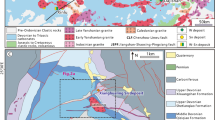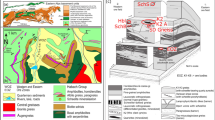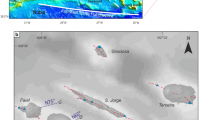Abstract
Plagioclase separates from the Layered Series (LS), Upper Border Series (UBS), and Marginal Border Series (MBS) of the Skaergaard intrusion were analyzed to examine major and trace element variations. In general, plagioclase from the LS, UBS, and MBS show similar trends in major elements vs. crystallization: SiO2, Na2O, and K2O progressively increase, and CaO and MgO progressively decrease with fractionation. No abrupt changes in the trends of major components of Skaergaard plagioclase during the differentiation of the intrusion are observed. Trace elements in plagioclase reflect changes in the Skaergaard magma and changes in plagioclase distribution coefficients with differentiation. Sr, Ga, and probably Ba are included elements in Skaergaard plagioclase, but were excluded from the other cumulus phases, and as a result systematically increased in the magma and plagioclase during differentiation. Be, Cs, Hf, Rb, Ta, U, and Zr, and the transition metals Co, Cr, Cu, Ni, Sc, V, and Zn were excluded elements in Skaergaard plagioclase, and remained low in plagioclase during differentiation. Changes in the abundances of these elements in plagioclase during differentiation reflect changes in their abundance in the magma. With the exception of the lower zone, which is enriched in the light rare earth elements, rare earth elements in LS plagioclase, in general, increase with differentiation of the Skaergaard intrusion, but decrease dramatically at the UZa/UZb boundary where abundant apatite first appears. Rare earth elements in UBS plagioclase followed a similar trend to LS plagioclase, except during the initial and final stages of differentiation. UBS plagioclase is much more enriched in rare earth elements during the final 20% of crystallization, except for Eu, which is similar in plagioclase from the two series. The observed trends suggest that the floor and roof sequences became isolated from each other and that the floor sequence may have been more reducing and the roof sequence more oxidizing during the final 20% of crystallization. As the Skaergaard magma ceased convection, or convected as isolated cells, during the final stages of differentiation, volatile elements may have accumulated in the UBS magma, resulting in an increase in ƒO2, and a decrease in Eu/Sm in UBS plagioclase. The observed trends of rare earth elements in plagioclase from the LS and UBS fit well with theoretical calculations that assume closed-system crystallization, and would be difficult to reconcile with any model requiring significant discharge of magma from the chamber during the final 20% of crystallization. The enrichment of light rare earth elements in plagioclase, suggests that the lower part of the intrusion re-equilibrated with a late, light rare earth element-rich fluid or melt. The recharge model proposed by earlier workers to explain anomalous Sr and Nd isotopes appears unlikely in light of the two to fourfold enrichment of light rare earth elements in these samples.
Similar content being viewed by others
Author information
Authors and Affiliations
Additional information
Received: 1 October 1999 / Accepted: 14 May 2000
Rights and permissions
About this article
Cite this article
Jang, Y., Naslund, H. Major and trace element composition of Skaergaard plagioclase; geochemical evidence for changes in magma dynamics during the final stage of crystallization of the Skaergaard intrusion. Contrib Mineral Petrol 140, 441–457 (2001). https://doi.org/10.1007/s004100000176
Published:
Issue Date:
DOI: https://doi.org/10.1007/s004100000176




